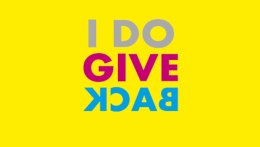Anneke Purz
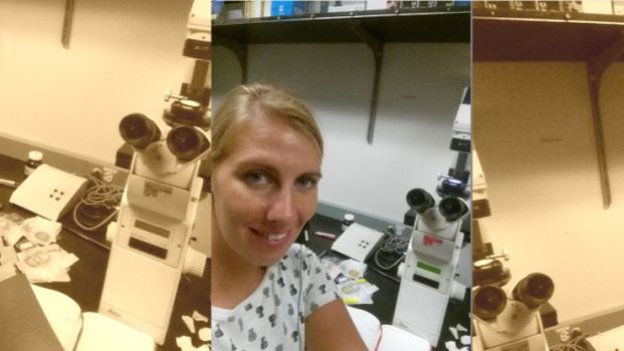 Privat
Privat
Anneke Purz conducting her research in the labortory
"It was a great experience for me to conduct this research visit with the support of the DAAD-Stiftung."
Anneke K. Purz is a student of the University of Oldenburg. After completing her bachelor’s degree in Biology, she went on to earn her master’s degree in Marine Environmental Studies. From August to November 2017, she completed a research visit at the University of Southern California (USC) on a short-term doctoral grant from the DAAD-Stiftung, donated by the Prof. Dr. Bingel Fund.
In the following report, Anneke Purz describes her fascinating research experience in Southern California:
As part of my dissertation on the propagation mechanisms of harmful algal blooms, or HAB, along natural gradients, I conducted several lab tests with various dinoflagellates. The Caron Lab on the Californian coast had isolated and sent them to me for my research work. It is well known that nutrients have a significant influence on the growth of phytoplankton. Because of the high nutrient variability in upwelling regions like the Californian coast, the tests I had previously conducted had focused on the quantitative variation of nutrients. Some species of phytoplankton, like the dinoflagellate Lingulodinium polyedrum, are capable of storing nutrients. This ability can be advantageous for species that live in areas with high nutrient fluctuations.
In the experiments I had already done for my dissertation, I investigated the growth and the competitive relationships of L. polyedrum under varying nutrient conditions. The focus of my research project in the United States, however, was on the interaction of L. polyedrum with a natural community when nutrients were added. For this we investigated whether nutrient enrichment at varying times played any relevant role in the bloom development of L. polyedrum.
Because I had already worked with phytoplankton species from the Californian coast, I had established contact with Prof. Dr. David Caron’s laboratory at the University of Southern California (USC) in Los Angeles. Because of the close thematic connection of my dissertation topic and Prof. Caron’s work and location, it was a great experience for me to conduct this research visit with the support (i.e. short-term doctoral grant) of the DAAD-Stiftung.
Preparation, arrival and living situation
Finding an apartment in Los Angeles while still in Germany was rather complicated. Unfortunately, my arrival coincided with the beginning of the semester at the American universities which meant that there was enormous demand for apartments. Despite the support of the lab colleagues in Prof. Dr. David Caron’s research group, who offered me lots of advice, but couldn’t provide me with accommodation, it was extremely hard to find a room. A good place to look for accommodation was the classifieds website “Craigslist”, where anyone can place an advertisement. That also means there are many scammers on the site as well. For a while I was in contact with someone who turned out to be scammer, which I only discovered after putting her profile image in Google Reverse, a search engine that finds the original source of images on the web. I came to really appreciate this tool while looking for an apartment.
During my search, I wrote to several potential landlords every day, but hardly received any responses. In the end, with a little luck, I found a good room via this platform. The interview process with my landlords took a long time; first I had to answer a long list of questions by email and then had several online conversations via Skype. I was very relieved to finally get the room in the end. However, not only did I have to transfer the first month’s rent in advance, but also a deposit of 1,900 dollars. Needless to say, I was a bit sceptical and unsure about the whole thing until I finally arrived in Los Angeles.
My landlords, Robin and Judi, turned out to be fantastic, hospitable and extremely nice people. One of the rooms was rented to their own adult children. After an exhausting trip that took almost 24 hours door to door, I landed in Los Angeles on 16 August 2017. While Robin kindly picked me up from the airport, his wife Judy was cooking me a welcoming meal. I was warmly received, which – after such a long trip and my previous misgivings – was an incredibly pleasant surprise. They had renovated my room prior to my arrival, and my bed was even freshly made. The house was located in Studio City, a very beautiful and safe district north of Hollywood Hills.
Compared to Germany, living in Los Angeles is expensive. I paid 950 dollars a month for my room, which was relatively inexpensive compared with many other places.
Project and workplace
Monday, 21 August 2017 was my first day of work which just happened to be the first day of classes for the USC students. The entire campus was packed with students who – like me – had no idea where they were going. USC has a very different campus structure than German universities. Everything looked like a movie – which could have something to do with the fact that lots of movies are set on American campuses. I was cordially welcomed into the research group under Prof. David Caron. The group is comprised of ten full-time employees and several research assistants. In my first days there, I received a detailed introduction to the laboratory and the methods they use. The structures in this laboratory are somewhat different than those in labs where I’ve previously worked, but I quickly got used to them after a few days. For years now, the lab has been collecting ocean water samples (samplings) every week from various locations along the coast of California and testing them for HABs. This is done in collaboration with various regional institutes. Thanks to these regular samplings, I was able to gain a good overview of the local phyto- and zooplankton communities in a very short period of time.
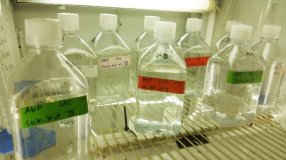
Privat
Especially in the beginning, I often discussed my planned trials in detail with Prof. Dr. Caron. I conducted two preliminary tests in the beginning to evaluate my test setup. In one test, I measured the effect of various nutrients (nitrates, phosphates with and without silicates – N, P, Si) on the development of different phytoplankton communities. In the second, I compared the development of phytoplankton communities with prefiltered (80µm) and unfiltered samples. The purpose of prefiltration was to prevent zooplankton from entering the sample and producing an additional trophic level to the test, which in turn would have affected the competitive relationships of the phytoplankton among themselves. However, we found that filtering removed too many phytoplankton species from the samples. We then decided to use a larger mesh (200µm) for prefiltering the samples in the real tests in order to remove the larger zooplankton, e.g. adult copepods, without losing the bulk of phytoplankton.
Due to lack of space, we decided to gather samples at different locations at different times and conduct separate experiments for each. We also expanded the nutrient manipulations (addition of N & P) with variations of silicates. Both nutrient compositions were tested with pulses at two different times. We also carried out a control without the addition of nutrients. Each variation consisted of four replicates so that both tests contained 20 units of 1 litre each. Due to the increased number of units, we chose to limit our focus to two different locations/communities.
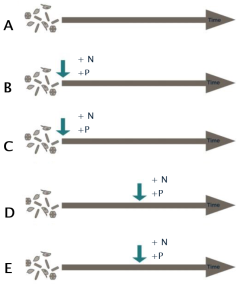
Privat
Scheme of the experimental setup
A: Control community without addition of nutrients
B: Early addition of nutrients (N and P)
C: Early addition of nutrients (N, P and Si)
D: Late addition of nutrients (N and P)
E: Late addition of nutrients (N, P and Si)
Because the sample collected at the coast on 11 September 2017 registered such a high number of Lingulodinium polyedrum cells, I drove out to Cabrillo Beach with a colleague the next day to collect a sufficient amount of water (25 l) for my first test. However, I had to cancel the test the following day because the density of L. polyedrum had significantly dropped on the sampling day. In the days that followed, several of my colleagues (who lived near the coast) went out every day to various locations to gather water samples so that I could test the L. polyedrum density levels. On 14 September we finally found a suitable location (Zuma Beach - Malibu). My colleague Alyssa drove out there the next morning to collect a sufficient amount of water for the test and brought it back to the lab. I am very grateful to Alyssa for sparing no effort so that I could have a “clean” water sample.
On Friday, 15 September, I began the first test with the samples collected from the first site. The filled bottles were kept in an incubator at 18°C with a 12-hour day/night rhythm. The test ran for a total of 15 days with nutrients added at the start or in a pulse on Day 3. We took cell counts every three days, and also tested for in vivo and extracted chlorophyll a.
On 10 October 2017, I began my second test which followed the same protocol as the first. The only difference consisted in the starting communities of phytoplankton. The samples for this test were taken from Point Dume, also located on the coast near Malibu. Although the samples for both tests were taken from sites in relative proximity, the phytoplankton community at the start of the second experiment was far more diverse and contained a high number of L. polyedrum cells.
Throughout my entire research visit, I spent time collecting data on phyto- and zooplankton communities. I analysed over 200 samples under the microscope during this period. I also measured the level of chlorophyll a in every sample. All of the sampled communities are still in storage and can be sent to me in Germany in case I encounter uncertainties in the analysis or have to repeat the sample counts.
In addition to my experiments, I attended the weekly research group meetings and took part in a trade literature discussion. I also used the opportunity to speak with my colleagues on research-related topics.
Conclusion
I only have words of praise for the research group under Prof. Dr. David A. Caron. I was extremely well integrated in the group and my colleagues supported me as much as they could. They were always there to offer advice and lend a hand if needed. They went above and beyond their duties and used every means available to make my stay as easy and successful as possible.
I was able to complete both experiments and collect the required data within the period of my research visit. In the coming months, I will be carrying out further analysis of these tests.
Prof. David Caron, myself and my supervisor Dr. Stefanie Moorthi from the University of Oldenburg have remained in close contact to ensure the successful conclusion of the projects in the best interest of both research groups.
Travelling and transportation / Work commute
I was something of an oddity in Los Angeles because I actually rode my bike through the city – at least some of the time. I really enjoy biking, but I found the traffic in Los Angeles especially challenging. The city infrastructure was designed and built for cars. If you don’t own a car and have to rely on the run-down public transportation system, travelling even short distances can take a long time. The advantage of taking public transport is that a ride only costs $1.75 – relatively cheap. But since cars are clearly the vehicle of choice in L.A., very few people use public transportation, which means that the busses come infrequently. To get to the beach from where I lived, it would take about 30 to 45 minutes by car, but with public transport, it would take two hours.
I would have liked to use my bike more (which my landlords kindly allowed me to borrow during my stay), because after all, the weather is truly fantastic all the time. However, there are hardly any bike paths, and many drivers don’t pay attention to cyclists. That’s why I mostly used the bike to reach the next Metro Rail station about 20 minutes away. From there, I’d take the subway downtown to the university. It took me about an hour to reach my workplace. But sometimes it took one and half hours because the trains often came late and didn’t seem to follow a fixed schedule.
I rented a car for a few days. That was an adventure– those six-lane freeways were a challenge for me! Nonetheless, I found that driving was a much more pleasant way to get around L.A. (except, of course, during rush hours). Because of the terrible gridlock during peak rush hours, my colleagues would commute to work at the craziest times – sometimes leaving home at four in the morning. On the plus side, people who start work that early get to enjoy the nice weather earlier in the afternoon.
Basically, it’s better to have a car. If you don’t have one, then you should try finding a place to live which is close to work, at best, near a Metro Rail station.
Country and people
During those three months, I met many friendly people. As a “newcomer”, I quickly felt right at home in the United States because most people are extremely friendly, interested and more open than people in Germany. Being so approachable, it’s normal to start a conversation with strangers on the street. Many of them were keenly interested in me as soon as they noticed my accent. This form of conversation was a little strange for me at first, especially since I’m from northern Germany. But eventually I came to enjoy this open, warm and very humorous form of small talk.
Los Angeles is a crazy city. Almost everyone wants to get into the movie business, and almost every day, film crews would be shooting some scene on campus or in my neighbourhood, which from an outsider’s point of view, appeared less glamorous than you might imagine. When he was younger, my landlord Robin had been a film director, but now he worked as a voiceover coach. As a member of the Directors Guild of America, he took me as his guest to exclusive film screenings. The headquarters of the Directors Guild of America in downtown L.A. has a luxurious screening room. Almost every day they hold free screenings for members only, followed by discussions with the directors. Each member is permitted to bring a guest, which is why I was fortunate to accompany Robin. I found the follow-up discussion with the two directors very interesting (both of whom had directed James Bond movies).
They have extremely delicious Mexican food in California. But people in Los Angeles generally pay attention to what they eat, which is why most food is no-fat, gluten-free, sugar-free and low-sodium. As an alternative, you can also get trendy “super foods” at every corner. Everyone finds their own lifestyle niche, and practically everyone I met loves living in Los Angeles.
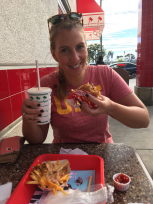
Privat
A special moment before my trip back home to Germany – my healthy diet takes a hiatus.
Glamourous lifestyles and extreme poverty often exist only metres apart. I was really shocked by how many homeless people there were. It seems that this is the result of a rather ineffective social insurance and health care system where people can quickly face financial ruin if they get sick. At moment like these, I gained a much better appreciation of the social security we have here at home in Germany. Knowing that I am entitled to social benefits and medical care even if I’m unemployed is an enormous relief.
One of the highlights during my visit to the United States was a concert by John Williams (composer of world-famous film scores, e.g. Star Wars, Indiana Jones and Jurassic Park) at the Hollywood Bowl, a gigantic open-air concert venue. I also took a weekend trip to San Diego to visit a friend who is working at the Scripps Institute of Oceanography as a PhD student. The city was also very pretty and a little less hectic than Los Angeles. I occasionally took hikes through Angeles Forest which was absolutely breath-taking.
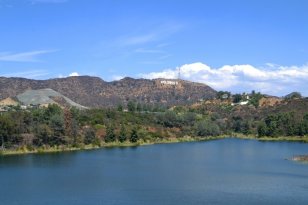
Privat
Summary
My three months in the US were very interesting, and I had a lot of fun. The first weeks were quite exhausting on account of jetlag, traffic chaos, masses of people, a small earthquake, scorching heat (Los Angeles was hit with an extreme heatwave while I was there, and the ash of wild fires covered Studio City for several days), a new job and the challenge of only speaking English. But after this period of acclimatisation, I felt very comfortable in Los Angeles – both privately and professionally. The reliably good weather allowed me – when I wasn’t doing intensive research – to enjoy my free time outdoors and become familiar with all the facets of this city.
Thank you
I wish to extend my heartfelt thanks to the DAAD-Stiftung and the Prof. Dr. Bingel Fund for financially supporting this project. I also would like to thank Ms. Lohmann and Dr. Lüter for their extremely interesting and enriching meeting.
A big thank-you goes to Dave Caron for his help on the job and the entire Caron Lab for all their kindness and support during those three months.
I also wish to thank my doctoral supervisor Stefanie D. Moorthi at the ICBM of the University of Oldenburg for her support with planning my research visit in the United States.
Contact:
Anneke K. Purz
Anneke.purz@uol.de
Editor’s note: The DAAD-Stiftung likewise thanks Anneke Purz for her detailed report which not only offers a vibrant insight into her intensive research work during her grant period, but also allows us to share in her many other experiences which students can gain during a research or study visit abroad.
As of winter 2017/18. The German version is the original.


